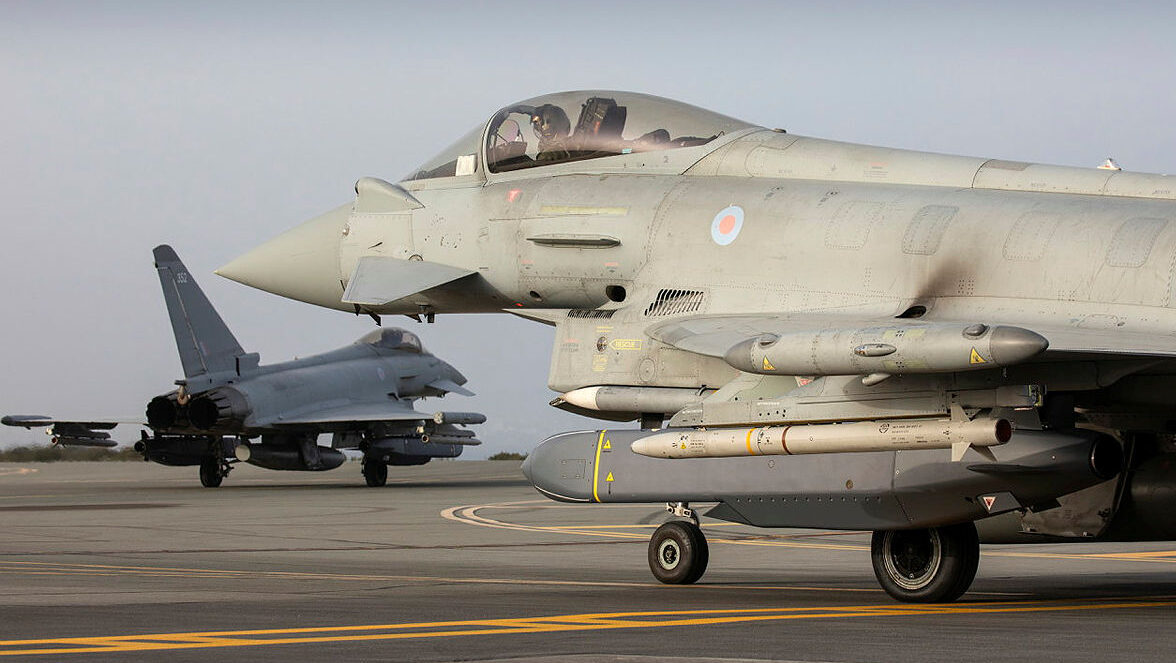After watching Ukraine, UK ‘looking at’ more risk-taking in weapons development, integration

A RAF Eurofighter Typhoon carries Storm Shadow long range missiles. (UK MoD)
BELFAST — Based on lessons learned from the war in Ukraine, the UK should consider “occasions” where it would be in the national interest to speed up the development of new weapons and transfer them into troops’ hands, even if it means taking more of a gamble than the government’s usually comfortable with, according to a top British weapons development official.
“Making these decisions can actually affect the safety of people, so what we’re looking at now, [considering] there will always be an end-state of a design for a weapon, there may be occasions where we want to take greater risk and therefore accelerate integration,” John Cunningham, Head of Weapons Evaluation and Capability Assurance (WECA) at the UK MoD, told the future combat air summit held by the Royal Aeronautical Society in London today.
While Cunningham was suggesting the UK take a more aggressive stance when it comes to the development of its own weapons, he cited a more general risk vs. reward calculation his office had recently been involved in regarding sending weapons to Ukraine.
When providing advice to UK Defence Secretary Ben Wallace about the recent decision to send air launched MBDA-made Storm Shadow long-range strike weapons, Cunningham said that his team had explained the risks involved.
“There is risk in some of the [Storm Shadow] technologies and there’s a greater strategic risk in the utilization of those weapons,” he added, a possible reference to the weapons being recovered by Russian forces or the ever-present fear of escalation.
The UK was the first Western country to send Storm Shadow, but other long-range weaponry sent to Kyiv includes US M142 High Mobility Artillery Rocket Systems (HIMARS). Storm Shadow offers a range beyond 250 kilometers and has been designed to strike fixed and hardened targets, according to the Institute of Strategic Studies. (The HIMARS system is capable of launching, but the US has only provided Ukraine with artillery that travels a fraction of the maximum distance.)
Cunningham also said that his team were consulted upon discovery of “photographic” evidence of a Brimstone missile being captured by a Russian soldier, though he did not say if UK security had been compromised or impacted by the event. Made by MBDA, the Brimstone is an air-launched close air support missile.
A British Brimstone missile reportedly captured by Russian forces in Zaporizhzhia Oblast. https://t.co/TmPMeUvwaK pic.twitter.com/DaRyGxG30i
— Rob Lee (@RALee85) May 8, 2022
Separately, WECA, Cunningham’s office, has partnered with a software company to better address supply chain availability issues as European and US industry continues to struggle with weapons production demands.
“We sort of discovered more or less with our [weapons] systems there were probably 25 different people involved in making it available,” said Cunningham. “We were working to the slowest pace of that. So we brought a company in that has very clever software, to look at that [issue] and try and join it together, to give us a rich picture.”
The work to improve availability continues but the main target is to use “evidence-based decision making” to determine whether to spend money on weapons or assess new data to better understand stockpile challenges.
To enhance weapon system capabilities, WECA also concentrates on delivering what Cunningham called spiral upgrades driven by new software integration that can be done much quicker than hardware upgrades. Weapon suppliers are also being offered classified briefings to “characterize” threats and support the optimal development of “all” weapon systems, before manufacturing and delivery phases.
“This really needs to be supported by lots of joint technology research and capability evaluation and innovation in terms of how we upgrade weapons,” said Cunningham.